LONDON – ev.energy, a software provider of managed electric vehicle (EV) charging to more than 35,000 EV drivers across the US, UK, Europe and Australia, provided the data for a new report by BloombergNEF (BNEF) based on over one million home charging sessions from ev.energy’s global database of EV drivers. The report finds that EV drivers can save over $1,000 per year by charging during off-peak hours compared to drivers relying on gasoline.
Among the insights, the BNEF report outlines that home EV charging habits have fundamentally shifted in the wake of the Covid-19 pandemic, with drivers staying plugged in for longer as a result of the transition to remote and hybrid work models.
“To charge their electric vehicles at home, drivers typically only require about 2.5 hours of charge but actually stay plugged in for more than 12 hours. This gives great flexibility for drivers to charge at the cheapest and greenest times for the grid,” said Ryan Fisher, Advanced Transport Senior Associate at BloombergNEF.
In the US, ev.energy’s charging optimization platform saves EV drivers in California an estimated $600 per year by charging during cheaper off-peak hours, and uses up to 70% lower-carbon electricity by aligning charging with real-time renewable energy generation. “Many drivers are used to waiting to find the cheapest gas station to refill their tanks. Smart-charging applies the same concept by waiting for the cheapest hours to charge, and then tops up the driver’s battery with low-carbon energy. This ends up saving the typical EV driver hundreds of dollars per year off their electricity bill,” said Joseph Vellone, ev.energy’s Head of North America.
By offering drivers access to low-carbon electricity while aggregating across a range of electric vehicles and chargers, ev.energy has built one of the world’s largest EV Virtual Power Plants. As the demand on the grid is expected to increase over the next decade, ev.energy enables grid operators such as the Electric Reliability Council of Texas (ERCOT) to reduce peak demand and prevent mandatory blackouts such as the one that impacted millions of Texans in February 2021.
“Before dynamic smart-charging, most EV drivers plugged in during peak hours and started charging immediately, which resulted in higher costs for consumers while presenting load-balancing challenges for the grid,” said Nick Woolley, CEO and co-founder of ev.energy. “Now, by integrating all the real-time data we have on energy networks with EV charging, we’re able to benefit every point along the energy supply chain – from drivers to grid operators to renewable energy generators. Beginning with the optimization of energy grid usage, we expect these effects to snowball and highlight the real-life impact of collective climate action.”
Through its unique insights into EV drivers’ charging habits, the report provides the industry with analysis to inform the future rollout of charging and smart-grid infrastructure globally to mitigate the potential effects of EVs on local and national power grids.













